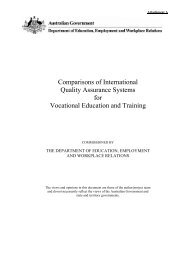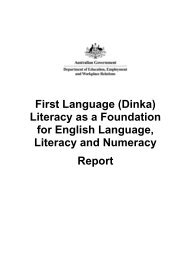Epidemics in a Changing World - Department of Innovation, Industry ...
Epidemics in a Changing World - Department of Innovation, Industry ...
Epidemics in a Changing World - Department of Innovation, Industry ...
You also want an ePaper? Increase the reach of your titles
YUMPU automatically turns print PDFs into web optimized ePapers that Google loves.
Text Box 1: The new H1N1 <strong>in</strong>fluenza, April 2009<br />
EpidemICs <strong>in</strong> a Chang<strong>in</strong>g <strong>World</strong><br />
Report <strong>of</strong> the Expert Work<strong>in</strong>g Group<br />
2<br />
The emergence <strong>of</strong> “sw<strong>in</strong>e-l<strong>in</strong>eage” A(H1N1) <strong>in</strong>fluenza virus <strong>in</strong>fections <strong>in</strong> humans and<br />
their transfer to sw<strong>in</strong>e occurred dur<strong>in</strong>g the compilation <strong>of</strong> this report. New stra<strong>in</strong>s <strong>of</strong><br />
seasonal human <strong>in</strong>fluenza viruses arise almost annually, requir<strong>in</strong>g the regular updat<strong>in</strong>g<br />
<strong>of</strong> seasonal <strong>in</strong>fluenza vacc<strong>in</strong>es. However, the emergence and spread <strong>of</strong> a dist<strong>in</strong>ctly<br />
new <strong>in</strong>fluenza virus, like the 2009 H1N1 virus, has occurred only a few times <strong>in</strong> the last<br />
century. Neither the tim<strong>in</strong>g nor the location <strong>of</strong> such events can be predicted. Such is the<br />
nature <strong>of</strong> most emerg<strong>in</strong>g <strong>in</strong>fectious diseases.<br />
The new H1N1 virus is believed to have developed when one human or animal was<br />
co-<strong>in</strong>fected with two different <strong>in</strong>fluenza viruses previously identified <strong>in</strong> sw<strong>in</strong>e <strong>in</strong> North<br />
America and Eurasia. 1 Because the genetic material <strong>of</strong> <strong>in</strong>fluenza viruses is divided <strong>in</strong>to<br />
eight separate segments, co-<strong>in</strong>fection allows “reassortment” to create new comb<strong>in</strong>ations<br />
<strong>of</strong> the eight segments. Occasionally reassorted viruses are <strong>in</strong>fectious and spread<br />
successfully. Whereas the 1918 pandemic <strong>in</strong>fluenza virus appeared to arise by mutation<br />
<strong>of</strong> an avian <strong>in</strong>fluenza virus, the 1957 and 1968 pandemics were both caused by reassorted<br />
viruses with new comb<strong>in</strong>ations <strong>of</strong> human and avian <strong>in</strong>fluenza genes. 2<br />
(Anne Kelso, pers.comm.)<br />
Figure 1: Quarant<strong>in</strong>e camp, South Australia, <strong>in</strong> the 1918–19 <strong>in</strong>fluenza pandemic<br />
Source: State Library <strong>of</strong> South Australia. Reproduced with permission <strong>of</strong> the copyright owner.
















